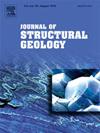断层诱发岩溶特征:来自巴西Potiguar盆地西北部poo Verde断裂尖端的启示
IF 2.6
2区 地球科学
Q2 GEOSCIENCES, MULTIDISCIPLINARY
引用次数: 0
摘要
本研究旨在了解影响和控制浅水碳酸盐岩层序岩溶作用的构造格架。本研究采用多尺度和多学科的方法来揭示结构网络与岩溶事件之间的相互作用。通过这种方式,进行了地震、卫星、无人机、探地雷达(GPR)和现场分析。三维地震数据分析强调了白垩纪北西-东南走向的千米尺度断裂带(poo Verde断裂系统)的存在,该断裂带以负花构造为特征,并伴有由合成断层和相对断层组成的张拉断层。沿着poo Verde断层系统的断层尖端部分定位的地震剖面证实了这种断层结构。在分析了航天飞机雷达地形任务(SRTM)数据和高分辨率无人机图像的区域轮廓后,我们确定了沿poo Verde断层尖端带定位的两个主要断层集。这里有一个主要的北西-东南走向的断层集和一个小的北-南走向的断层集。这些构造特征与不同的构造阶段有关。在这个区域,Furna Feia洞穴系统是局部的。此外,现场证据表明,新生代原有构造重新激活,导致裂缝密度和强度增加。探地雷达剖面上的白云岩段比石灰岩段显得更变形。研究表明,poo Verde断裂影响、控制和促进了影响碳酸盐岩的白云石化和岩溶作用。本文章由计算机程序翻译,如有差异,请以英文原文为准。
Fault-induced karst features: Insights from the Poço Verde Fault tip in the Northwestern portion of Potiguar Basin, Brazil
This work aims to understand the tectonic framework that influenced and controlled the karstification processes along a shallow water carbonate sequence. Both multi-scale and multi-disciplinary approaches are presented in this work to unveil the interaction between the structural network and the karstification events. In this manner, seismic, satellite, drone, Ground Penetration Radar (GPR), and field analyses were performed. The analysis of 3D seismic data highlighted the presence of a Cretaceous NW-SE striking kilometric scale fault zone (Poço Verde Fault System) characterized by a negative-flower structure associated with a transtension fault composed of synthetic and antithetical faults. A seismic profile localized along the fault tip portion of the Poço Verde Fault System confirms this fault architecture. After analyzing regional lineaments in Shuttle Radar Topography Mission (SRTM) data and high-resolution drone images, we have identified two main fault sets localized along the Poço Verde fault tip zone. Here, a main NW-SE striking fault set and a minor N-S striking fault set are present. These structural features are associated with different tectonic phases. In this sector, the Furna Feia Cave System is localized. Furthermore, field evidence indicates a Cenozoic reactivation of pre-existing structures, which has led to an increase in fracture density and intensity. A dolomitic interval in GPR sections appears more deformed compared to the limestone portions. The presented work suggested that the Poço Verde Fault impacted, controlled, and promoted both dolomitization and karstification processes that affected the studied carbonate rocks.
求助全文
通过发布文献求助,成功后即可免费获取论文全文。
去求助
来源期刊

Journal of Structural Geology
地学-地球科学综合
CiteScore
6.00
自引率
19.40%
发文量
192
审稿时长
15.7 weeks
期刊介绍:
The Journal of Structural Geology publishes process-oriented investigations about structural geology using appropriate combinations of analog and digital field data, seismic reflection data, satellite-derived data, geometric analysis, kinematic analysis, laboratory experiments, computer visualizations, and analogue or numerical modelling on all scales. Contributions are encouraged to draw perspectives from rheology, rock mechanics, geophysics,metamorphism, sedimentology, petroleum geology, economic geology, geodynamics, planetary geology, tectonics and neotectonics to provide a more powerful understanding of deformation processes and systems. Given the visual nature of the discipline, supplementary materials that portray the data and analysis in 3-D or quasi 3-D manners, including the use of videos, and/or graphical abstracts can significantly strengthen the impact of contributions.
 求助内容:
求助内容: 应助结果提醒方式:
应助结果提醒方式:


